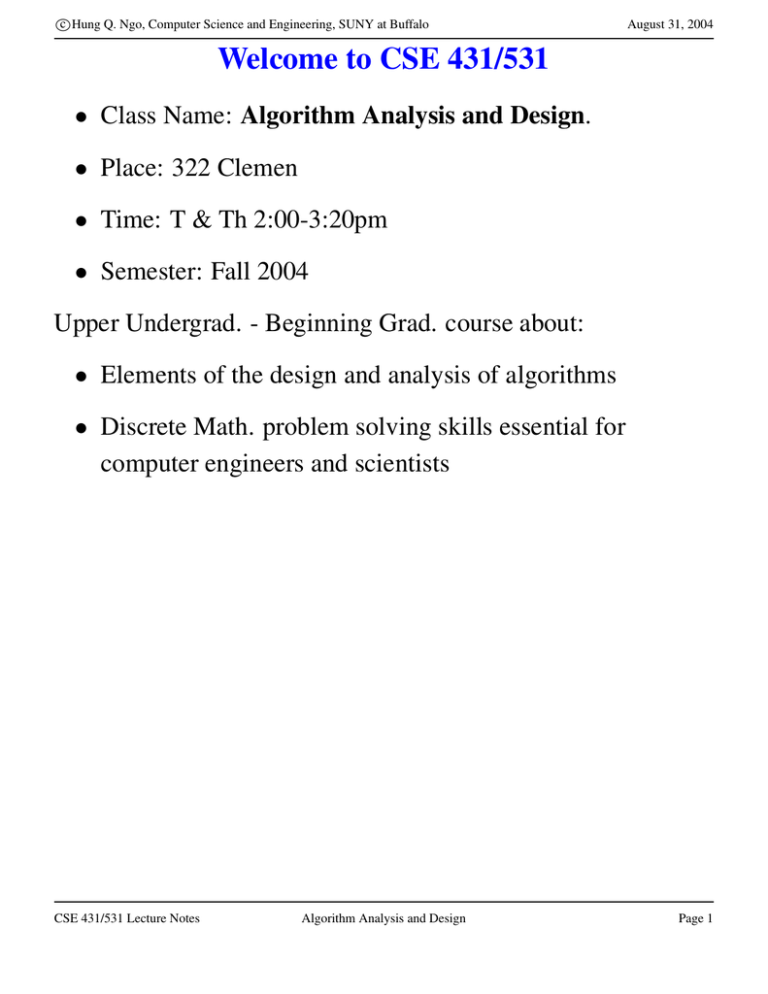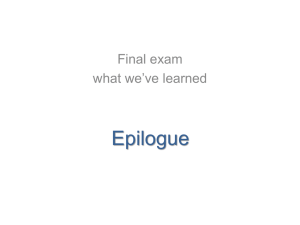Document 10791716
advertisement

c Hung Q. Ngo, Computer Science and Engineering, SUNY at Buffalo August 31, 2004 Welcome to CSE 431/531 • Class Name: Algorithm Analysis and Design. • Place: 322 Clemen • Time: T & Th 2:00-3:20pm • Semester: Fall 2004 Upper Undergrad. - Beginning Grad. course about: • Elements of the design and analysis of algorithms • Discrete Math. problem solving skills essential for computer engineers and scientists CSE 431/531 Lecture Notes Algorithm Analysis and Design Page 1 c Hung Q. Ngo, Computer Science and Engineering, SUNY at Buffalo August 31, 2004 Today’s Agenda • Administrative Matters • Brief Overview of the Course CSE 431/531 Lecture Notes Algorithm Analysis and Design Page 2 c Hung Q. Ngo, Computer Science and Engineering, SUNY at Buffalo August 31, 2004 Who should take this course? Anyone who is either • a computer science/engineering student • interested in getting to know the most fundamental area of Computer Science or • forced to take it because it’s required and/or all other courses were filled up The catches are • Data Structures (CSE250 or equivalent), • Calculus II (or some formal calculus/analysis course), • and a course which requires formal proofs (discrete Math.) ... not crucial if you’re motivated enough, though. CSE 431/531 Lecture Notes Algorithm Analysis and Design Page 3 c Hung Q. Ngo, Computer Science and Engineering, SUNY at Buffalo August 31, 2004 Who should teach this course? • Hmm ... as if you have a choice CSE 431/531 Lecture Notes Algorithm Analysis and Design Page 4 c Hung Q. Ngo, Computer Science and Engineering, SUNY at Buffalo August 31, 2004 Teaching Staff Instructor: • Dr. Hung Q. Ngô • Assistant Professor, CSE-SUNY Buffalo Teaching Assistants: Ph.D. candidates • Mr. Guang Xu: recitation section A2, Wednesday 3:00pm-3:50pm, 220 Clemen • Mr. Zhiyong Lin: recitation section A1, Friday 11:00am-11:50am, 213 Obrian • Recitation A3 (Tuesday 4:00pm-4:50pm, 101 Baldy) will be held alternatively between the two TAs. CSE 431/531 Lecture Notes Algorithm Analysis and Design Page 5 c Hung Q. Ngo, Computer Science and Engineering, SUNY at Buffalo August 31, 2004 When/Where to talk to me? Algorithm 1 (Your First Algorithm). To ask the Prof. a question, try 1: 2: 3: 4: 5: send questions to class newsgroup sunyab.cse.531 email him (hungngo@cse.buffalo.edu) come to office hours - 238 Bell Hall, 10-12am Thursdays sneak in whenever the door is opened goto 1 CSE 431/531 Lecture Notes Algorithm Analysis and Design Page 6 c Hung Q. Ngo, Computer Science and Engineering, SUNY at Buffalo August 31, 2004 Course objectives • Have fun learning! • Grasp a few essential ideas of algorithm analysis and design – asymptotic notations and analysis – basic parallel sorting networks – typical algorithm design methods: divide and conquer, greedy, dynamic programming, network flows analysis – basic graph algorithms: BFS, DFS, MST, ... – the notions of NP-Completeness and approximation algorithms • Gain substantial problem solving skills in designing algorithms and in solving discrete mathematics problems CSE 431/531 Lecture Notes Algorithm Analysis and Design Page 7 c Hung Q. Ngo, Computer Science and Engineering, SUNY at Buffalo August 31, 2004 Course Materials Required textbook: • Cormen, Leiserson, Rivest, and Stein, Introduction to Algorithms (2e), 1180pp, MIT Press, 9/2001. Online Materials: class website (see syllabus for URL) Recommended references • Knuth’s Classic three volume The Art of Computer Programming. • Aho, Hopcroft and Ullman Data Structures and Algorithms, Addison Wesley, 1/1983. CSE 431/531 Lecture Notes Algorithm Analysis and Design Page 8 c Hung Q. Ngo, Computer Science and Engineering, SUNY at Buffalo August 31, 2004 Work Load • Heavy! So, start early! • Approx. 30 pages of dense reading per week • 5 written homework assignments (to be done individually) • 1 midterm exam • 1 final exam CSE 431/531 Lecture Notes Algorithm Analysis and Design Page 9 c Hung Q. Ngo, Computer Science and Engineering, SUNY at Buffalo August 31, 2004 Grading Policy • 5 assignments: 8% each • 1 midterm exam: 25% • 1 final exam: 35% Note: • Assignments are due at the lecture’s end on due date – 1 day late (24 hours): 10% (of max score) reduction – each extra date: 30% more • Incomplete grade and make-up exams: not given, except in provably extraordinary circumstances CSE 431/531 Lecture Notes Algorithm Analysis and Design Page 10 c Hung Q. Ngo, Computer Science and Engineering, SUNY at Buffalo August 31, 2004 Academic Honesty Absolutely no tolerance on plagiarism • 0 on the particular assignment/exam for first attempt • Fail the course on the second plus report to department and school • Consult the University Code of Conduct for details • In summary, I will take plagiarism very seriously Note: • You are encouraged to discuss class materials and homework problems with classmates • The final writeup must be on your own, in your own words CSE 431/531 Lecture Notes Algorithm Analysis and Design Page 11 c Hung Q. Ngo, Computer Science and Engineering, SUNY at Buffalo August 31, 2004 Absolutely No Lame Excuses • I have to go home early, please let me take the final on Dec 1. ... NO, NO, NO, NO, not even one day before the actual exam. (Do you know how long it takes me to come up with a good exam?) • I had a fight with my girlfriend ... yeah, right • I’ve studied hard, I understood the material very well, ... but I got a C. Please consider giving me A... you’re funny • I think I deserve a better score, please give me some work to do next semester to improve the score ... sorry, I have no time. CSE 431/531 Lecture Notes Algorithm Analysis and Design Page 12 c Hung Q. Ngo, Computer Science and Engineering, SUNY at Buffalo August 31, 2004 How to make it more interesting? How to do well in this course? • Ask questions in class The only stupid question is the question you don’t ask • Suggestions are always welcome • Attend lectures • Do homework/reading assignments early • At least, skim through reading assignments before lectures • Print out lecture notes before lectures We, the TAs and I, are here to help you. Don’t hesitate to ask. CSE 431/531 Lecture Notes Algorithm Analysis and Design Page 13 c Hung Q. Ngo, Computer Science and Engineering, SUNY at Buffalo August 31, 2004 A few motivating examples Example 1 (Fibonacci numbers). Write an algorithm to calculate the nth Fibonacci number, given n F0 = 0 F1 = 1 Fn = Fn−1 + Fn−2 , n ≥ 2 Example 2 (Primality testing). Given a natural number n, return YES if it is a prime number, NO otherwise. Agrawal, M.; Kayal, N.; and Saxena, N. ”Primes Is in P.” Preprint, Aug. 6, 2002. http://www.cse.iitk.ac.in/primality.pdf Example 3 (Shortest Path). Devise an algorithm to find a shortest path from a source (e.g. your computer) to a destination (e.g. www.nfl.com) in the Internet Example 4 (Steiner Tree). Given a set of cities, find an algorithm to assist in building a highway system connecting all these cities, so that that total length of highways is minimized. CSE 431/531 Lecture Notes Algorithm Analysis and Design Page 14 c Hung Q. Ngo, Computer Science and Engineering, SUNY at Buffalo August 31, 2004 Aha - Algorithms! Algorithm 2 (FibA). Input: non-negative integer n. 1: 2: 3: 4: 5: if n ≤ 1 then return n else return (FibA(n − 1) + FibA(n − 2)) end if Algorithm 3 (FibB). Input: non-negative integer n. 1: 2: 3: 4: 5: 6: 7: 8: 9: 10: if n ≤ 1 then return n; else a ← 0; b ← 1; for i from 1 to n − 1 do temp ← a; a ← b; b ← temp + a; end for return b; end if Question: What are the pros and cons? CSE 431/531 Lecture Notes Algorithm Analysis and Design Page 15 c Hung Q. Ngo, Computer Science and Engineering, SUNY at Buffalo August 31, 2004 Analyzing Algorithms • mean of “roughly predicting” the resources required • Resources: – How fast?: time complexity – Memory requirement?: space complexity – Others: communication bandwidth, hardware costs, ... Need a specific machine model: RAM, parallel computers, quantum computers, DNA computers, ... • We’re mostly concerned with time complexity: a rough estimate of running time wrt the input size • We will be very informal until NP-completeness is discussed CSE 431/531 Lecture Notes Algorithm Analysis and Design Page 16 c Hung Q. Ngo, Computer Science and Engineering, SUNY at Buffalo August 31, 2004 Designing Algorithms I assume you know what it means. Approaches • Ask someone • Hack around ’til it works • Brute force • Incremental • Divide and conquer • Greedy • Dynamic programming • Formulate the problem as a network flow, linear/non-linear programming problem • A stroke of genius • Give up Note: “programming” is not programming CSE 431/531 Lecture Notes Algorithm Analysis and Design Page 17 c Hung Q. Ngo, Computer Science and Engineering, SUNY at Buffalo August 31, 2004 Lastly • Hope to learn as much from you as you’d learn from me • Enjoy the ride! Next time: • Growth of functions • Solving recurrences CSE 431/531 Lecture Notes Algorithm Analysis and Design Page 18






